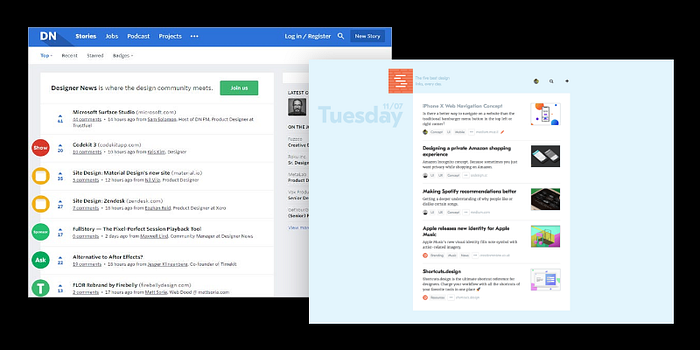Hey there, design enthusiasts.
Do you remember the first time you booted up a graphic editor (Paint doesn’t count!)? For me, it was Photoshop 5.0 (or was it 4.0?) on my old rattling 233 MHz Pentium II when I was around 16 years old. I’ll never forget that magical moment when I realized the power I had at my fingertips. It felt like discovering the One Ring and being unable to let go (my precious).
I didn’t leave my room for 8 hours. I still remember the masterpiece I created — it was a portrait of a good friend that I transformed, making him look like the face of Rocky after a fight with Apollo Creed. No tutorials or guidance — just trial and error. And it looked amazing!
The field of design has come a long way since then. Today, that old Pentium II wouldn’t be able to handle a single Chrome tab, and Photoshop has stopped counting its versions a long time ago. Loads of great new tools have come up, shaping the way we design today.
Let’s take a walk down memory lane and remember the legendary tools, companies, and sources that have cemented their place in the Design Hall of Fame. There’s a lot of fallen giants too.
Buckle up, we’re about to take a nostalgic ride.

Adobe: The Pioneers and Their Lasting Legacy
Some tools have withstood the test of time and continue to be integral to the design process. Adobe Photoshop, launched in 1988, revolutionized the way we edit images and create graphics. Its versatility and powerful features have made it a staple for designers worldwide. Similarly, Adobe Illustrator, released in 1987, has been the go-to tool for vector graphics, allowing designers to create scalable artwork with precision.
Flash: The Animation Trailblazer
No trip down memory lane would be complete without mentioning Adobe Flash. Launched in 1996, Flash became the go-to tool for creating animations and interactive content on the web. It brought a whole new level of creativity to websites and was beloved by designers for its ability to make the web more dynamic and engaging. However, Flash’s reliance on plugins and its vulnerability to security issues led to its decline. By the late 2010s, HTML5 and other technologies had taken over, and Flash was officially discontinued in 2020.
The Game Changers
As the internet became more prevalent, new platforms emerged, offering innovative ways for designers to showcase their work and connect with others. Behance and Dribbble quickly became the social networks for designers, providing spaces to share portfolios, discover trends, and find inspiration. These platforms have not only stood the test of time but have also evolved, adapting to the changing needs of the design community.
The Rise of Specialized Tools
The 2000s and 2010s saw a surge in specialized design tools tailored to specific aspects of the design process. Sketch, launched in 2010, became the darling of UI/UX designers with its intuitive interface and powerful features. Meanwhile, InVision introduced a collaborative approach to prototyping, making it easier for teams to work together seamlessly.

Fallen Giants: The Platforms That Couldn’t Keep Up
Now that we’ve set the stage, let’s dive into the stories of some design platforms that were once the kings and queens of the design world but have since either shut down or faded into the background.
Forrst: The Community Treehouse
Forrst was the place to be for designers and developers back in 2010. Imagine a cozy treehouse where you could share your work, get feedback, and connect with other creatives. But as time went on, Forrst struggled to grow and monetize. In 2013, it was bought by Colourlovers and eventually shut down. The rise of competitors like Dribbble didn’t help its cause either.

Designer News and Sidebar.io: Gone but Not Forgotten
Designer News and Sidebar.io were your daily stops for the latest design trends and inspiration. Designer News was like Reddit for designers, while Sidebar.io gave you a daily dose of curated links. Both platforms struggled with keeping users engaged and making money. With social media and other content aggregators taking over, these platforms couldn’t keep up and recently shut their doors, leaving many designers searching for new sources of inspiration.

InVision: From Star to Struggler
Remember when InVision was the go-to tool for prototyping and collaboration? It was the darling of the design field. But with the announcement that it will discontinue its design collaboration services by the end of 2024, following the acquisition of Freehand by Miro, things have changed. The rapid rise of more integrated tools like Figma has pushed InVision to the sidelines. However, not all is lost! InVision had a shining moment when they acquired us, Muzli. To the delight of over 750,000 designers, they put us on a lifeboat and set us free just before the ship started to sink. Talk about a heroic rescue!
Sketch: Once a Giant, Now a Memory
Sketch took the design field by storm when it launched in 2010. It was the top choice for UI/UX designers. But being exclusive to macOS and slower to innovate compared to its competitors led to its decline. Figma’s cross-platform capabilities and superior collaboration features have wooed many Sketch users away. While Sketch is still around, its presence in the design community isn’t what it used to be.

Adobe Photoshop: The Veteran Adapts
Adobe Photoshop has been the go-to tool for designers for decades. But even this veteran has seen a shift. Photoshop, once used for all types of design work, is now more focused on photo editing and graphic design. Tools like Adobe XD, Figma, and Sketch have taken over the web and UI/UX design spaces. This shift is due to the specific features these newer tools offer, catering to modern web and app design needs.
Why Did These Platforms Fall?
- Inability to Adapt: These platforms couldn’t keep up with the rapidly changing design landscape. For example, Forrst couldn’t innovate fast enough, and Sketch’s macOS exclusivity limited its user base.
- Competition: Newer, shinier tools with better features and user experiences emerged. Figma’s real-time collaboration and cross-platform support made it a preferred choice over Sketch and InVision.
- Monetization Challenges: Platforms like Designer News and Sidebar.io couldn’t figure out how to make enough money to stay afloat.
Should Other Tools Be Worried?
The design field is always evolving, and even the current favorites need to stay on their toes. Tools like Adobe XD, Axure, and Webflow need to keep innovating and adapting to user needs. Webflow, with its powerful web design capabilities, faces stiff competition from other no-code and low-code platforms, so it needs to ensure it continues to evolve and meet the demands of modern web designers. Dribbble, while still popular, needs to ensure it evolves with the changing landscape of designer portfolios and community interaction to avoid a similar fate.
Muzli: Here to Stay
In a world where many beloved platforms have closed their doors, we’re here to assure you that Muzli isn’t going anywhere. We’re committed to bringing you daily design inspiration, the latest trends, and all the resources you need to keep your creativity flowing. So, designers, don’t worry! Muzli is here for the long haul and will remain your creative home for many years to come.
Stay inspired, stay creative, and remember — Muzli’s got your back!














